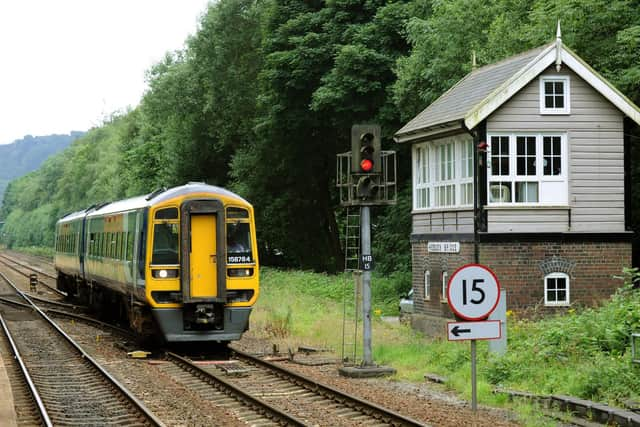Electrification of Calder Valley line crucial to recovery of public transport
and live on Freeview channel 276
However, developing key issues such as the electrification of the Calder Valley line, which West Yorkshire Combined Authority (WYCA) and Calderdale Council are campaigning for, and ensuring “greener” and more reliable bus services will be crucial, councillors heard.
Mick Sasse, of WYCA, said: “We have got recovery to do, but it is not as though people have abandoned the railway in droves.”
Advertisement
Hide AdAdvertisement
Hide AdCoun Jane Scullion (Lab, Luddenden Foot) said she felt electrifying the Calder Valley line would be crucial alongside really good bus services including those serving rural routes where there were issues, and “greener” buses.


Coun Regan Dickenson (Con, Rastrick) said he had heard electrification of the rail line posed logistical difficulties and asked whether, if this was the case, using trains running on hydrogen would be more cost effective.
Mr Sasse said hydrogen fuelled trains were mainly used on routes with less density.
“In terms of Calder Valley, to be honest traditional electrification is, and ought to be, a ‘no brainer’,” he said, adding that the necessary work could be done without having to re-engineer tunnels.
Advertisement
Hide AdAdvertisement
Hide AdMr Sasse said the Calder Valley line has a great potential for leisure and educational traffic and the recent formation of a Community Rail Partnership with Rochdale Council should aid this.
Coun Audrey Smith (Lab, Sowerby Bridge) said the cost of using services were an issue and Mrs Sasse said the expense of rail travel, including issues such as “tunnel tax” where increases were applied cross boundary, for example between Walsden and Littleborough stations, were an issue nationally.
Coun Paul Bellenger (Lib Dem, Greetland and Stainland) stressed the need for bus services to be reliable and asked how they were monitored.
Helen Ellerton of WYCA, said service operators said congestion and service operation were issues and collectively how this could be improved were among next steps.
Advertisement
Hide AdAdvertisement
Hide AdThe WYCA officers said rail and bus services have been impacted hard since the first lockdown in 2020, with social distancing measures meaning people favoured private cars for travelling, if they had them.
Road traffic levels were up to 113 per cent of pre-pandemic levels in parts of West Yorkshire in the summer of 2021, while another factor affecting passenger numbers was more people working from home or working flexibly and not travelling into offices as often, as well as a decrease in leisure journeys.
For rail services, this meant a 79 per cent drop in passenger numbers in 2020-21 compared to 2020-19 after a period of strong growth, said the report to councillors.
Calderdale Council’s Place Scrutiny Board were considering impacts on Calderdale, and heard Halifax Rail Station experienced an 81 per cent drop in traffic during this period with commuter numbers showing the biggest hit amid staff having to isolate affecting service reliability and delays to infrastructure works.
Advertisement
Hide AdAdvertisement
Hide AdBut leisure rail travel did recover most markedly in the summer months when some restrictions were eased with Northern Rail seeing patronage of its services recover to 61 per cent of 2019-20 levels in the second quarter of 2020-21.
Freight growth was also slightly up (0.7 per cent) on pre-pandemic levels in the same period.
Mr Sasse said crucial aspects looking ahead will be the impact of the Government’s Integrated Rail Plan on Calderdale including electrification.
In West Yorkshire, bus patronage was down to ten per cent of pre-pandemic levels in April 2020 and, as with rail, service reliability was also affected by staff having to isolate while, by the end of 2021, a ten per cent shortfall in drivers due to some being attracted by jobs in the haulage industry also had impact.
Advertisement
Hide AdAdvertisement
Hide AdBut by October last year bus usage levels were back to around 75 per cent of pre-pandemic levels, a new Government policy promoting bus travel had been introduced and WYCA, including Calderdale, in partnership with bus operators were developing the West Yorkshire Bus Alliance.
Alongside this WYCA and partners were developing the Enhanced Bus Partnership, whose work includes goals such as introducing greener buses, simplifying bus fares and building a cohesive network of buses across West Yorkshire – and a target of increasing the number of bus passengers by 25 per cent by 2027.
Taking rail and bus services together, the officers felt that, providing care was taken not to take short term decisions which might have a detrimental impact long term, there were opportunities to significantly reduce road traffic.
“The current situation for public transport is uncertain, but a brighter future awaits,” concluded their report.
Advertisement
Hide AdAdvertisement
Hide Ad* Support your Halifax Courier by becoming a digital subscriber. You will see 70 per cent fewer ads on stories, meaning faster load times and an overall enhanced user experience. Click here to subscribe